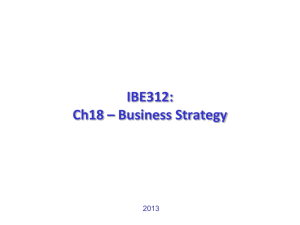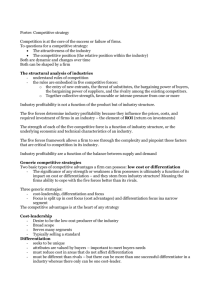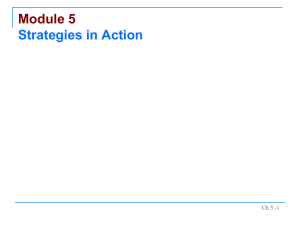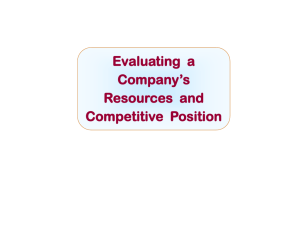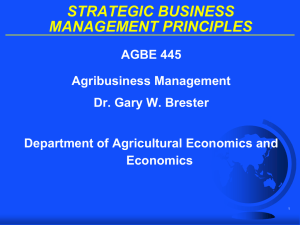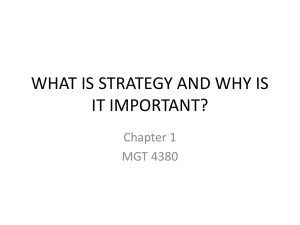Get Notes (5) Here
advertisement
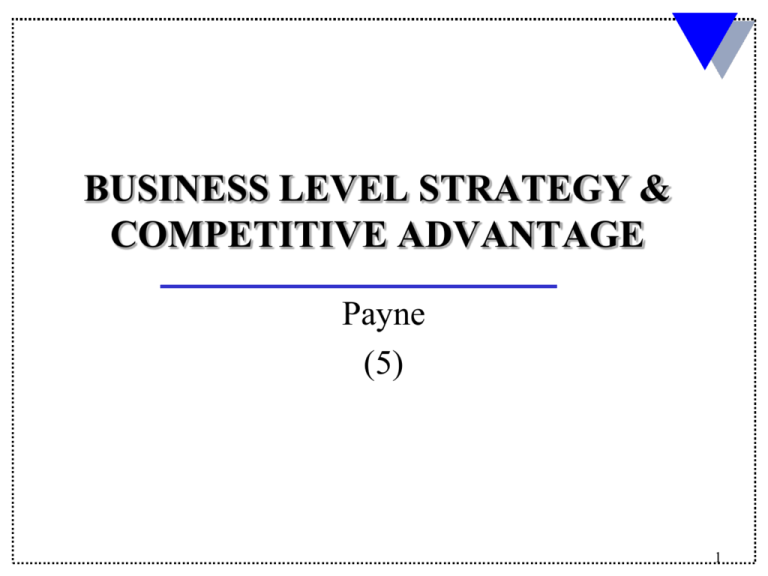
BUSINESS LEVEL STRATEGY & COMPETITIVE ADVANTAGE Payne (5) 1 Strategic Decisions at Multiple Levels • Corporate Strategy • • • • Moves to achieve diversification Actions to boost performance of individual businesses Capturing synergy among business units (2 + 2 = 5 effects) ! Establishing investment priorities and steering corporate resources into the most attractive business units • Business Strategy • • • • • • Forming responses to changes in industry and competitive conditions, buyer needs and preferences, economy, regulations, etc. Crafting competitive moves leading to sustainable competitive advantage Building competitively valuable competencies and capabilities Uniting strategic initiatives of functional areas Addressing strategic issues facing the company Functional Strategy • • • • Game plan for a strategically-relevant function, activity, or business process Details how key activities will be managed Provide support for business strategy Specify how functional objectives are to be achieved 2 Core Competencies and Strategy Core competencies The resources and capabilities that have been determined to be a source of competitive advantage for a firm over its rivals Strategy An integrated and coordinated set of actions taken to exploit core competencies and gain a competitive advantage Business-level strategy Actions taken to provide value to customers and gain a competitive advantage by exploiting core competencies in specific, individual product markets 3 Definition of Competitive Advantage The essence of strategy lies in creating tomorrow’s competitive advantages faster than competitors mimic the ones you possess today. - Gary Hamel and C.K. Prahalad • COMPETITIVE ADVANTAGE exists when a firm’s strategy gives it an edge in: – – Defending against competitive forces and Securing customers …such that the firm earns (or has the potential to earn) a persistently higher rate of profit. 4 Gaining of Competitive Advantage • COMPETITIVE ADVANTAGE comes with the offering of SUPERIOR VALUE through: –Offering buyers a –Offering a good product at a lower price better product/service buyers think is worth a premium price 5 Business-Level Strategy Business-level strategy: an integrated and coordinated set of commitments and actions the firm uses to gain a competitive advantage by exploiting core competencies in specific product markets. Key Issues: • What good/service to offer customers? • How to manufacture or create the good or service? • How to distribute the good/service in the marketplace? 6 The Decision Logic of Strategy Formulation May be Corporate or Business Strategic Decisions Establishment of mission, vision, values, objectives -- the Directional Strategies Identification, evaluation, and selection of -- the Adaptive Strategies Identification, evaluation, and selection of -- the Market Entry Strategies Identification, evaluation, and selection of -- the Positioning Strategies Implementation through development of -- the Functional & Operational Strategies 7 8 Adaptive Strategies • Delineate how the organization will adapt to changes in the environment or competitive landscape: Expansion •Diversification •Vertical Integration •Market Development •Product Development •Penetration Contraction •Divestiture •Liquidation •Harvesting •Retrenchment •Outsourcing Stabilization •Enhancement •Status Quo Corporate Strategy Decisions Only 9 Adaptive: Expansion-Market/Product Development & Penetration • Market Development -- expand geographic service area or by targeting new market segments within the present area. – Building new store near high-growth residential areas • Product Development -- introduction of new product/services in present markets, through product/service enhancement and line expansion. • Penetration -- centered on promotional, distribution, and pricing strategies with current products or services. – 1 in 12 wins Coca-Cola or “buy one, get one free” for Tinactin. 10 11 The BCG Portfolio Matrix 22% Stars Question Marks 20% 18% 16% 14% 12% 10% Cash Cows 8% Dogs 6% 4% 0.1X 1X 1.5X 2X 0 10X 2% Relative Market Share 12 Adaptive: Stabilization Strategies When past strategies have been viewed as appropriate and few changes are required: • Enhancement - when organization just “needs to do things better;” takes forms of CQI, TQM programs, speeding delivery, adding flexibility to service design • Status Quo - maintenance of services at the current levels, defending against competitors 13 14 Market Entry Strategies • Carry out the expansion and stabilization strategies through: – Purchase Strategies: May be Corporate Decision if in Different Market • Acquisition – purchase of new product, unit or organization • Licensing – lease technology, product or service • Venture Capital Investment – “try out” investment option – Cooperation Strategies: • Mergers – two organizations come together as one • Strategic Alliance – long-term agreement to work together • Joint Venture – combined resources to work on common issue of interest – Developmental Strategies: • Internal Development – uses existing resources or structures • Internal Ventures – establishes new entity for developmental purposes 15 Positioning Strategies • Business Level Positioning: – Position the organization vis-à-vis other organizations within the market – These are market-oriented and best articulate the competitive advantage within the market – May be market-wide (or broad-based) or directed at a particular segment (or niche-focused) • Based largely on Generic Business Strategies: – – – – – Low-Cost Leadership Strategy Broad Differentiation Strategy Best-Cost Provider or Integrated Strategy Focused Low-Cost Strategy Focused Differentiation Strategy 16 “Three” Generic Strategies Competitive Advantage Lower Cost Differentiation Industry -Wide Cost Leadership Differentiation Competitive Scope Single Segment Focus 17 “Four” Generic Strategies Competitive Advantage Lower Cost Differentiation Broad Target Cost Leadership Differentiation Competitive Scope Narrow Target Cost Focus Differentiation Focus 18 “Five” Generic Strategies Competitive Advantage Lower Cost Differentiation Broad Target Competitive Scope Narrow Target Cost Leadership Differentiation Best Cost Provider Cost Focus Differentiation Focus 19 20 A Low-Cost Leadership Strategy Objective: Open up a sustainable cost advantage over rivals, using lower-cost edge as a basis either to: – – Under-price rivals and reap market share gains OR Earn higher profit margin selling at going price Keys to Success: • Make achievement of low-cost relative to rivals the THEME of firm’s business strategy • Find ways to drive costs out of business year-after-year Characteristics • Cost conscious corporate culture • Efficient scale facilities • Tightly controlled production costs and overhead • Minimized costs of sales, R&D and service • Efficient manufacturing facilities • Simplified production processes • Intensive scrutiny of budget requests 21 Drivers of Cost Advantage • Economies of Scale – Indivisibilities – Specialization and Division of Labor • Economies of Learning – Increased Dexterity – Improved Coordination and Organization • Process Technology and Process Design – Mechanization and Automation – Efficient Utilization of Materials – Increased Precision • Product Design – Design for Automation – Designs to Economize on Materials • Input Costs – – – – Location Advantages Ownership of Low-Cost Inputs Bargaining Power Supplier Cooperation • Capacity Utilization – Ratio of Fixed to Variable Costs – Costs of Installing and Closing Capacity • Managerial / Organizational Efficiency – Organizational Slack 22 A Low-Cost Strategy Works Best When: • • • • • • Price competition is vigorous Product is standardized or readily available from many suppliers There are few ways to achieve differentiation that have value Most buyers use product in same ways Buyers incur low switching costs Buyers are large and have significant bargaining power 23 A Low-Cost Strategy Fails When: • Being overly aggressive in cutting price (revenue erosion of lower price is not offset by gains in sales volume--profits go down, not up) • Low cost methods are easily imitated by rivals • Becoming too fixated on reducing costs and ignoring – – – • Buyer interest in additional features Declining buyer sensitivity to price Changes in how the product is used Technological breakthroughs open up cost reductions for rivals 24 Structure for Cost Leadership Strategy • Operations is main function • Process engineering is • • • Office of the President emphasized over R&D Large centralized staff Formalized procedures Structure is mechanical, job roles highly structured Engineering Centralized Staff Accounting Operations Marketing Personnel 25 A Differentiation Strategy Objective • Incorporate differentiating features that cause buyers to prefer firm’s product or service over the brands of rivals Keys to Success • • Find ways to differentiate that CREATE VALUE for buyers and that are NOT EASILY MATCHED or CHEAPLY COPIED by rivals Not spending more to achieve differentiation than the price premium that can be charged Characteristics • Uniqueness is achieved in ways that: – – – Buyers perceive as valuable Rivals find hard to match or copy Can be incorporated at a cost well below the price premium that buyers will pay 26 Differentiation Strategy Differentiation actions required: Developing new systems and processes Shaping perceptions through advertising Quality focus Capability in R&D Maximize human resource contributions through low turnover and high motivation Factors Driving Differentiation: Unique product features Quality of inputs Unique product performance Exceptional skill or experience Exceptional services Detailed information New technologies Extensive personal relationships with buyers and suppliers 27 A Differentiation Strategy Works Best When: • There are many ways to differentiate a product that have value and please customers • Buyer needs and uses are diverse • Few rivals are following a similar type of differentiation approach • Technological change is fast-paced and competition is focused on evolving product features 28 A Differentiation Strategy Fails When: • Trying to differentiate on a feature buyers do not perceive as lowering their cost or enhancing their well-being • Over-differentiating such that product features exceed buyers’ needs • Charging a price premium that buyers perceive is too high • Failing to signal value • Not understanding what buyers want or prefer and differentiating on the “wrong” things 29 Structure for Differentiation Strategy President and Limited Staff R&D New Product R&D Marketing Marketing Operations Finance Human Resources • Marketing is the main function for tracking new product ideas • New product R&D is emphasized • Most functions are decentralized • Formalization is limited to foster change and promote new ideas • Overall structure is organic; job roles are less structured 30 Best Cost Provider/Integrative Strategy • Objective Combine a strategic emphasis on low-cost with a strategic emphasis on differentiation – Make an upscale product at a lower cost – Give customers more value for the money Keys to Success • • Create superior value by MEETING OR EXCEEDING buyer expectations on product attributes and BEATING their price expectations Be the low-cost producer of a product with GOOD-TOEXCELLENT product attributes, then use cost advantage to UNDERPRICE comparable brands 31 Integrative Strategy: A Hybrid or the “Mega-Strategy”? • Competitive advantage comes from matching close rivals on key product attributes and beating them on price. • Success depends on having the skills and capabilities to provide attractive performance and features at a lower cost than rivals. • A best-cost producer can often out-compete both a lowcost provider and a differentiator when • • Standardized features/attributes won’t meet the diverse needs of buyers Many buyers are price and value sensitive **The most powerful competitive approach a company can pursue is to strive relentlessly to become a lower-and-lower cost producer of a higher-and-higher caliber product. 32 Major Risk of Integrated Strategy • An integrated cost/differentiation business level strategy often involves compromises (neither the lowest cost nor the most differentiated firm) • The firm may become “stuck in the middle” lacking the strong commitment and expertise that accompanies firms following either a cost leadership or a differentiated strategy 33 A Focus / Niche Strategy Objective • • Involves concentrated attention on a narrow piece of the total market Serve niche buyers better than rivals Keys to Success • • Choose a market niche where buyers have distinctive preferences, special requirements, or unique needs Develop unique capabilities to serve needs of target buyer segment Two Types • Achieve LOWER COSTS than rivals in serving the segment-- A low-cost strategy • Offer niche buyers SOMETHING DIFFERENT from rivals-- A differentiation strategy 34 A Focused Strategy Works Best When: • Costly or difficult for multi-segment rivals to serve specialized needs of target niche • No other rivals are concentrating on same segment • Firm’s resources do not allow it to go after a bigger piece of market • Industry has many different segments, creating more focusing opportunities 35 A Focused Strategy Fails When: • Competitors find effective ways to match a focuser’s capabilities in serving niche • Niche buyers’ preferences shift towards product attributes desired by majority of buyers--the niche becomes part of the overall market • Segment becomes so attractive it becomes crowded with rivals, causing segment profits to be splintered 36 37 Offensive and Defensive Strategies Offensive Strategies Are undertaken to build new or stronger market positions and/or create competitive advantage. Key Insight: The chances for a successful offensive initiative are improved when it is based on a company’s resource strengths and strongest competencies and capabilities. Defensive Strategies Can protect competitive advantage, but rarely are the basis for creating advantage. Key Insight: When to make a move is as important as what move to make. Two defenses – 1) Block avenues challengers can take in mounting offensive attacks, 2 ) Make it clear any challenge will be met with strong counterattack 38 Attacking Competitor Strengths Options: • Offer equally good product at a lower price • Offer a better product at the same price • Leapfrog into next-generation technologies • Add appealing new features • Run comparison ads • Construct new plant capacity • Offer a wider product line • Develop better customer service capabilities 39 Attacking Competitor Weaknesses Basic Approach Concentrate company strengths and resources directly against a rival’s weaknesses Weaknesses to Attack • • • • • Geographic regions where rival is weak Segments rival is neglecting Go after those customers a rival is least equipped to serve Rivals with weaker marketing skills Introduce new models exploiting gaps in rivals’ product lines 40 Guerrilla Offenses Approach Use principles of surprise and hit-and-run to attack in locations and at times where conditions are most favorable to initiator Appeal Well-suited to small challengers with limited resources Options • Focus on narrow target weakly defended by rivals • Challenge rivals where they are overextended and when they are encountering problems • Make random scattered raids on leaders • • • Occasional low-balling on price Intense bursts of promotional activity Legal actions charging antitrust violations, patent infringements, or unfair advertising 41 Preemptive Strikes Approach Involves moving first to secure an advantageous position that rivals are foreclosed or discouraged from duplicating! Options Expand capacity ahead of demand in hopes of discouraging rivals from following suit Tie up best or cheapest sources of essential raw materials Move to secure best geographic locations Obtain business of prestigious customers Build an image in buyers’ minds that is unique & hard to copy Secure exclusive or dominant access to best distributors Acquire desirable, but struggling, competitor 42
